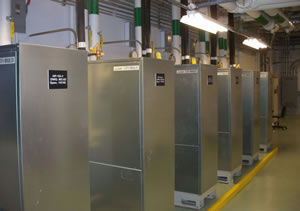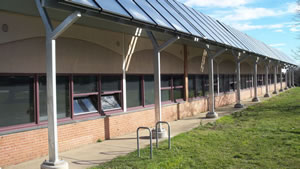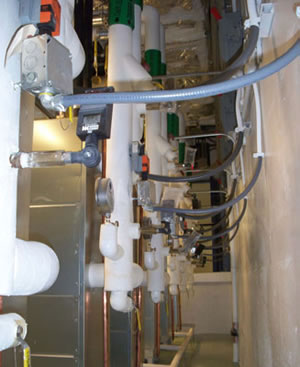Buildings As Teaching Tools

PHOTOS COURTESY OF MITSUBISHI ELECTRIC
Students at the Minnie Howard Ninth-Grade Campus in Alexandria, Va., not only benefit from one of the most innovative green renovations in the country, but they also get to learn all about it through a unique curriculum designed to show and tell them about conservation.
Like most buildings constructed in the 1950s, Minnie Howard suffered from limited cooling and heating capabilities and poor air circulation — not the best environment for learning.
To deal with those issues as well as reduce energy use and increase sustainability, Alexandria City Public Schools (ACPS) undertook an ambitious “greenovation” program. The goal: Build and renovate energy-efficient, green schools that lower utility costs and improve the learning environment, and then use those technologies and practices to teach students how to reduce their impact on the planet.
The effort gained momentum in 2007 when the ACPS board adopted the Leadership in Energy and Environmental Design (LEED) requirements for Environmentally Sustainable Schools. The following year, ACPS contracted with Energy Education, Inc. (EEI), a Dallas based company that works with school systems to conserve energy and reduce utility costs.
The team chose Minnie Howard as the prototype for the first greenovation initiative at ACPS. Named for a mother of seven who founded the Alexandria PTA in 1912 and created the city’s school lunch program, the 700-student facility eases the transition for ninth graders between middle school and senior high school.
Since the school was a prototype for this new initiative, the architect and engineers had to get especially creative. And they did, devising an innovative package of technologies to form one of the most energy-efficient systems in the nation. Along the way, Minnie Howard was transformed into a laboratory for testing green building technologies and practices that could be implemented throughout the district’s nearly 20 facilities.
HOW IT WORKS
The heart of the energy makeover, completed in 2009, is a creative combination of solar energy, geothermal energy, high-efficiency water-source heat pumps and a solar heat exchanger.
A collection of 42 solar panels installed on the front of the school provides water heating while shading south-facing windows. Any unneeded heat energy from the solar array is stored underground in a field of 60 geothermal wells. Located 300 feet below the school’s parking lot, the mechanical wells supply water to the cooling and heating system. The stable underground temperature (about 50 degrees Fahrenheit) reduces the amount of energy required to cool or heat the water.

Array of Sunshine. A collection of 42 solar panels were installed on the front of the school to provide water heating, and serve to shade the south-facing windows. Any unneeded heat energy from the solar array is stored underground in a field of 60 geothermal wells located 300 feet below the school’s parking lot. In addition, the school’s old mechanical room has morphed into a greenovation laboratory that displays dashboards, gauges and web data in real time as well as other instructional materials that explain the components of the systems
A total of 8,000 feet of piping connects the geothermal closed loop water system to six new water-source heat pumps that replaced two decrepit, locomotive-sized boilers and an elderly chiller. Using Variable Refrigerant Flow (VRF) zoning technology, the innovative, multi-unit HVAC system by Mitsubishi Electric US Cooling & Heating Division (Mitsubishi Electric) runs only when cooling or heating is needed, provides zoned conditioning, and can cool and heat different zones at the same time. The result: spectacular energy savings.
Minnie Howard’s average yearly energy savings is calculated at 63 percent with total net lifecycle savings of $406,680. Those savings will continue to accrue because the geo-solar system uses 87 percent less non-renewable energy than a conventional system, produces 10 percent less waste energy and reduces natural gas consumption by 80 percent. There are cosmic benefits as well: The system cuts greenhouse gas emissions by 50,000 kg of CO2 per year.
The contractor who installed the heat pumps and the plumbing network raved about the system. “Of all my years in HVAC contracting, this Minnie Howard system stands in a league of its own,” said Chris Ott, project manager, Shapiro & Duncan, Inc., Rockville, Md. “It’s an ingenious bit of green engineering. The school went from an antiquated chiller that was keeping water at 40 degrees and two huge, inefficient boilers maintaining 180-degree water all the time — even if it wasn’t needed — to a Mitsubishi Electric variable speed condensing unit coupled to a geothermal well system that only runs if an indoor air handler needs cooling or heating. Add to this the ability to cool and heat simultaneously and to zone with multiple condensing units — another energy-saving milestone.”
Ott was impressed with the idea of using water as a heat-exchange medium in conjunction with the geothermal wells. “It was a very logical solution for energy conservation,” he says, adding that the unique two-pipe system also reduced the cost of labor and materials needed for installation. “The installation was hassle free, and the system started up the very first time with no glitches. When you consider there are 8,000 feet of piping, that’s amazing!”
OTHER GREENOVATIONS
In addition to energy efficiency, other ACPS greenovation initiatives include recycling, composting, conserving water, reducing storm water runoff and limiting the need for artificial lighting.
A green roof at Minnie Howard not only saves energy by insulating the roof, but also reduces stormwater runoff. A bioretention filtration system reduces runoff from new parking lots by replacing traditional sewer inlets. These soil boxes, or rain gardens, use trees and shrubs to filter out harmful pollutants from urban runoff. To conserve water, the school uses low-flow plumbing fixtures and xeriscaping, a type of environmentally friendly landscaping that employs only native, drought-resistant plants.
To lower artificial lighting needs, Minnie Howard employs automated lighting controls, LED lighting and solar tubes that direct sunlight from the rooftop to classrooms, bathrooms and corridors. These solar tubes were expected to save hundreds of dollars per year in electricity and maintenance costs per classroom.
Using Minnie Howard as the prototype, ACPS has expanded its greenovation program to other school buildings. James K. Polk Elementary School, for example, installed the geo-solar system tested at Minnie Howard but went further by using solar cells to generate electricity from sunlight to power the school. The new Polk classrooms are on track to be ACPS’s first net-zero classrooms and are expected to feed energy back into the electrical grid.
GETTING A GREEN EDUCATION
 Attaining energy-efficient, green schools is an admirable achievement in itself. But the school district had another, equally lofty goal.
Attaining energy-efficient, green schools is an admirable achievement in itself. But the school district had another, equally lofty goal.
“While an environmentally sustainable facility is a truly significant achievement, it pales in importance compared to the actions students going through these facilities will take in their lifetimes,” reads an ACPS working group report. “It is only through a curriculum that makes students aware of the larger environmental implications of their everyday actions that we can achieve this larger goal.”
The report goes on to recommend that curriculum specialists investigate how lesson plans can incorporate information about LEED standards and include a visual learning tool such as a dashboard-like display of various operating systems in real time. “All aspects of building operations (system wide) should be examined for lessons they might be able to teach students.”
Another recommendation: ACPS should provide in-service education about efficient energy use and environmentally sustainable practices for faculty and staff.
Each time the school system launches a green building initiative, students learn about the technology and its impact on the environment. Each school in the district has an environmental steward who is offered a stipend intended to be funded by energy savings. The stewards help connect students with green initiatives within the school district, educate students about green-collar careers, promote sustainability-focused learning activities and organize their school’s participation in Earth Day and other eco-friendly events. The stewards also sponsor school clubs to teach students how to reduce their energy consumption and get involved in school composting and recycling efforts.
In addition, some students help tend sustainable gardens that grow the fresh produce served at lunch. These activities give students hands-on experience with green practices that ACPS hopes will stay with them.
At Minnie Howard, green lessons are as close as the basement. The school’s old mechanical room has morphed into a greenovation laboratory that displays dashboards, gauges and Web data in real time as well as other instructional materials that explain the components of the systems and how they work together.
Reaching into the larger community, ACPS supports a Green Apprenticeship program in partnership with the Alexandria court system and other organizations. This after-school program provides basic job skills and teaches green technology concepts to at-risk teens.
 When it comes to energy efficiency and sustainability, the school district has a compatible partner in the city of Alexandria, whose eco-efforts go beyond greening the schools. All renovations and new construction of multi-family and municipal buildings must now meet the requirements of LEED Silver certification.
When it comes to energy efficiency and sustainability, the school district has a compatible partner in the city of Alexandria, whose eco-efforts go beyond greening the schools. All renovations and new construction of multi-family and municipal buildings must now meet the requirements of LEED Silver certification.
HOW THEY DID IT
ACPS is not a wealthy school district, and these green initiatives were undertaken during tough economic times. But thanks to far-sighted school officials and community members, the job is getting done.
“The key to pushing greenovation initiatives through is encouraging people to think forward — past the initial cost and toward total cost over the lifespan of the systems and the total energy savings involved,” said David Conrath, who shepherded the greenovation program as ACPS’s facility manager.
Most important to obtaining funding for green initiatives, according to Conrath, is “encouraging people to think of what will make the most productive, positive education environment for the children, rather than thinking about a quick, cheap fix for now.”
Minnie Howard and her seven children would all approve.
This article originally appeared in the School Planning & Management October 2013 issue of Spaces4Learning.